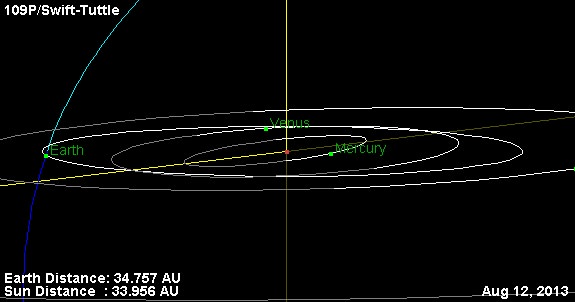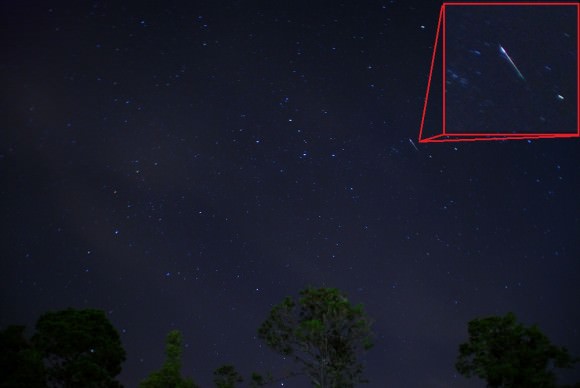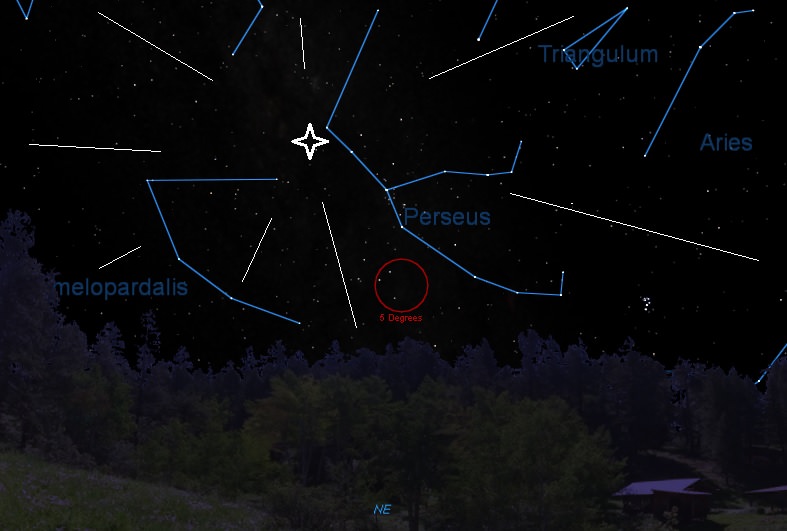Get set for the meteoritic grand finale of summer.
Northern hemisphere summer that is. As we head into August, our gaze turns towards that “Old Faithful” of meteor showers, the Perseids. Though summer is mostly behind us now, “meteor shower season” is about to get underway in earnest.
Pronounced “Pur-SEE-ids,” this shower falls around the second week of August, just before school goes back in for most folks. This time of year also finds many the residents of the northern hemisphere out camping and away from light-polluted suburban skies.
This year also offers a special treat, as the Moon will be safely out of the sky during key observation times. The Moon reaches New phase on August 6th at 5:51 PM EDT/ 9:51 Universal Time (UT) and will be a 32% illuminated waxing crescent around the anticipated peak for the Perseid meteors on August 12th. And speaking of which, the Perseids are infamous for presenting a double-fisted twin peak in activity. This year, the first climax for the shower is predicted for around 13:00 UT on August 12th, favoring Hawaii and the North American west coast, and the second peak is set to arrive 13 hours later at 02:00 UT, favoring Europe & Africa.
Nodal crossing for the Perseid stream and Earth’s orbit sits right around 18:00 to 21:00 UT on August 12th for 2013. The shower derives its name from the constellation Perseus, and has a radiant located near Gamma Persei at right ascension 3 hours 4 minutes and a declination of +58 degrees. Atmospheric velocities for the Perseids are on the high end as meteor showers go, at 59km/sec.
Of course, like with any meteor shower, it’s worth starting to watch a few days prior to the peak date. Although meteor streams like the Perseids have been modeled and mapped over the years, there are still lots of surprises out there. Plus, starting an early vigil is insurance that you at least catch some action in the event that you’re clouded out on game day! Like we mentioned in last week’s post on the Delta Aquarids, the Perseids are already active, spanning a season from July 17th to August 24th.
The Zenithal Hourly Rate for the Perseids is generally between 60-100 meteors. The ZHR is the number of meteors you could expect to see during optimal conditions under dark skies with the radiant directly overhead. Rates were enhanced back in the 1990’s, and 2004 saw a ZHR of 200.

The source of the Perseids is comet 109P/Swift-Tuttle. Discovered on July 16th-19th, 1862 by astronomers Lewis Swift & Horace Tuttle, Swift-Tuttle is on a 133.3 year orbit and last passed through the inner solar system in late 1992. This comet will once again grace our skies in early 2126 AD.
The Perseids are also sometimes referred to as the “tears of St Lawrence,” after the Catholic saint who was martyred on August 10th, 258 AD. The Perseids have been noted by Chinese astronomers as far back as 36 AD, when it was recorded that “more than 100 meteors flew thither in the morning.” The annual nature of the shower was first described by Belgian astronomer Adolphe Quételet in 1835.
Enhanced rates for the Perseids marked the return of comet Swift-Tuttle in the 1990s. Recent years have seen rates as reported by the International Meteor Organization at a ZHR=175(2009), 91(2010), 58(2011), & a resurgence of a ZHR=122 last year.
Just what will 2013 bring? There’s one truism in meteor observing—you definitely won’t see anything if you do not get out and observe. Meteor shower observing requires no equipment, just clear skies and patience. Watch in the early hours before dawn, when the rates are highest. Meteors can occasionally be seen before midnight, but are marked by lower rates and slow, stately trains across the sky. Some suggest that best viewing is at a 45 degree angle away from the radiant, but we maintain that meteors can appear anywhere in the sky. Pair up with a friend or two and watch in opposite directions to increase your meteor-spotting chances.
We also like to keep a set of binoculars handy to examine those smoke trains left by bright fireballs that may persist seconds after streaking across the sky.
And speaking of which, there has also been some spirited discussion over the past week as to whether or not the Perseids produce more fireballs than any other shower. I certainly remember seeing several memorable fireballs from this shower over the years, although the Geminids, Leonids and Taurids can be just spectacular on active years. The stated r value of the Perseids is one of the lowest at 2.2, suggesting a statistically high percentage of fireballs.
And in the realm of the strange and the curious, here are just a few phenomena to watch/listen for on your Perseid vigil;
– Can you “hear” meteors? Science says that sounds shouldn’t carry through the tenuous atmosphere above 50 kilometres up, and yet reports of audible meteors as a hiss or crackle persist. Is this an eye-brain illusion? Researchers in 1988 actually studied this phenomenon, which is also sometimes reported during displays of aurora. If there’s anything to it, the culprit may be the localized generation of localized electrophonic noises generated by Extra/Very Low Frequency electromagnetic radiation.
– Can meteor streaks appear colored? Green is often the top reported hue.
– Can meteors appear to “corkscrew” during their trajectory, or is this an illusion?

Wide-field photography is definitely a viable option during meteor showers. Just remember to bring extra charged batteries, as long exposure times will drain modern DSLRs in a hurry!
And did you know: you can even “listen” to meteor pings on an FM radio or portable TV? This is a great “rain check” option!
And there’s still real science to be done in the world of meteor shower studies. The International Meteor Organization welcomes counts from volunteers… and be sure to Tweet those Perseid sightings to #Meteorwatch.
Also be sure to check out the UK Meteor Observation Network, which has just launched their live site with streaming images of meteors as they are recorded.
Good luck, clear skies, and let the late 2013 meteor shower season begin!
-And be sure to post those Perseid pics to the Flickr forum on Universe Today… we’ll be doing photo essay roundups from observers around the world!

